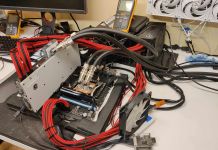AMD has now officially announced that the next generation graphics cards from AMD will use the new memory standard GDDR5. We’ve been covering the development of GDDR5 and it has been going surprisingly smooth, while we’ve also been notifying you about the latest updates on the upcoming RV770 circuit. Stories of RV770 using GDDR5 has been around for long, but it’s now official, if anyone ever doubted it, that the next generation Radeon will use the new and much faster memory standard GDDR5.
”The days of monolithic mega-chips are gone. Being first to market with GDDR in our next-generation architecture, AMD is able to deliver incredible performance using more cost-effective GPUs,” said Rick Bergman, Senior Vice President and General Manager, Graphics Product Group, AMD. ”AMD believes that GDDR5 is the optimal way to drive performance gains while being mindful of power consumption. We’re excited about the potential GDDR5 brings to the table for innovative game development and even more exciting game play.”
AMD was a big contributor to GDDR4, alas it did not prove to be that much faster than GDDR3, mainly due to poor timings. GDDR5 on the other hand is already up and running at frequencies beyond 4GHz, more than twice the speed of GDDR3. The pure data rate is in fact even higher according to AMD’s press release. GDDR5 can move data at five times the speed of GDDR3, four times that of GDDR4.
”Qimonda has worked closely with AMD to ensure that GDDR5 is available in volume to best support AMD’s next-generation graphics products,” said Thomas Seifert, Chief Operating Officer of Qimonda AG. ”Qimonda’s ability to quickly ramp production is a further milestone in our successful GDDR5 roadmap and underlines our predominant position as innovator and leader in the graphics DRAM market.”
Although, there so much more to GDDR5 than just the higher frequencies, and even though the fastest chips of today operate at 4.5GHz, 5GHz is very much feasible. One of the new features is improved error detection mechanisms for less system margin and more stable systems. It also brings a new adaptive interface timing, which means there is no need for trace length matching, thus cheaper PCBs.
Last but not least is the data eye optimization, which includes such key features as data/address bit inversion and adjustable driver strengths, voltages and terminations. Best case scenario this will lead to faster interface tweaking, relaxed transmission lines and, again, cheaper PCBs. So in the end, even if the GDDR5 chips may be more expensive and require more traces, the PCB design will be simpler and overall cheaper. Add to that, that GDDR5 is many times faster than GDDR3 and can operate over a narrower bus and still reach the same actual bandwidth.




















Leave a Reply